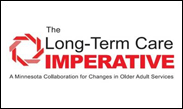From Aging Services of Minnesota and Care Providers of Minnesota:
Imagine an 85 year old woman who has been progressively receiving more care at home from family and paid caregivers. As her needs have grown in recent years, she has exhausted the limits of family and in-home support and is beginning to feel isolated from her community. She has decided it’s time to move into a setting that provides support services. Her family will pay with their own money for Mom to be in the community of her choice. However, before they can sign a lease, a new law now requires that Mom talk with someone at the State to get a certification number that permits this move.
This law – among many passed behind closed doors in the wee hours of the morning – will require government counseling for any individual before they can sign a lease in a Housing with Services establishment (e.g., assisted living, senior housing , supportive living). While the goal of delivering useful and available information is a laudable one, the new law misses the mark in many ways and is emblematic of a much larger problem we have in our approach to planning for long-term care, both as individuals and as a state.
There is no doubt that the most pressing issues we face today are directly linked to our aging population. Government simply cannot continue to be the primary source of funding for longterm health care. We are on an unsustainable path. We need a game-changer. The ultimate game-changer would be a system that empowers more individuals to take greater responsibility for planning and financing their long-term care, decades before they will actually need any services. This not only will shift the cost burden away from government, but more importantly – it will put more control back in the hands of individuals and families.
What we don’t need is a bigger role for government and added bureaucracy in the form of a state mandate, particularly for a service that 85 percent of people pay for with their own money.
The idea that better information can help consumers make better decisions, and perhaps save the state dollars, is right on. Minnesota leads the nation both in quality and access to a wide array of long-term care options. Resources that make it easier for consumers to navigate their choices are most certainly a part of the solution.
Unfortunately, the new mandatory counseling law gets the timing all wrong by requiring counseling at the very last minute, when a person’s needs are immediate and they are ready to move into a new setting.
The average age of an individual entering assisted living is 85 years old – by this time, most have already have lived at home as long as possible, exhausted family and community support and now need a higher level of care. A state requirement to receive counseling when individuals and families have immediate needs or face a crisis situation is not likely to provide the kind of financial planning benefits the law is designed to deliver. The time to start planning for a college education isn’t on high school graduation day. It starts years earlier with research, conversations about goals, assessment of financial resources, exploring support that might come from family or friends.
Planning for long-term health care is no different – we just aren’t talking about it. Rather than seeking ways to encourage individuals and families to plan for their future needs, the legislature created a larger role for government that sends a disturbing message: when one becomes a “senior citizen” they are no longer able to make smart decisions without government intervention.
Lawmakers from both parties agree that this law must be re-examined in the next legislative session. Let’s go back to the drawing board and discuss more effective ways to make it easier for Minnesotans to take more responsibility and have greater control over their long-term health needs.
 Gayle Kvenvold is president and CEO of Aging Services of Minnesota and Patti Cullen is president and CEO of Care Providers of Minnesota. Together, these organizations represent the Long-Term Care Imperative.
Gayle Kvenvold is president and CEO of Aging Services of Minnesota and Patti Cullen is president and CEO of Care Providers of Minnesota. Together, these organizations represent the Long-Term Care Imperative.
